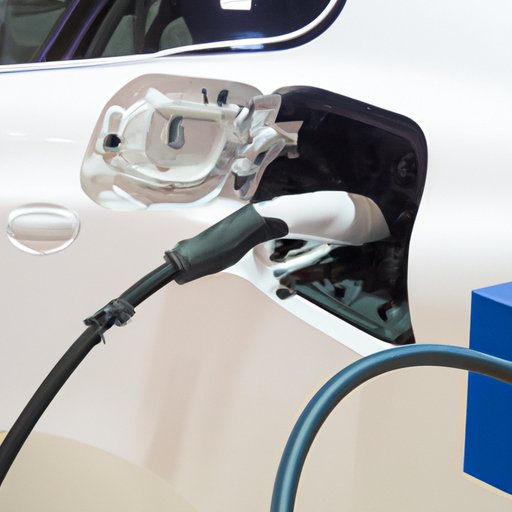Introduction
A hybrid car is a type of vehicle that combines two or more power sources to generate energy. This combination can include both an internal combustion engine and one or more electric motors. The goal of a hybrid car is to reduce emissions while still providing an efficient driving experience. In this article, we’ll explore how a hybrid car works and the benefits of owning one.

Exploring the Mechanics of Hybrid Cars
Hybrid cars rely on several different components to operate. These components include electric motors, internal combustion engines, battery packs, and regenerative braking systems. Let’s take a closer look at each of these components.
Examining the Components of Hybrid Cars
The first component of a hybrid car is an electric motor. Electric motors are powered by electricity stored in a battery pack. The battery pack is charged using the energy generated from the internal combustion engine and regenerative braking systems. The electric motor provides power for the wheels, allowing the car to move.
The second component of a hybrid car is an internal combustion engine. This is the same type of engine found in traditional gasoline-powered vehicles. The engine burns gasoline to produce energy, which is then used to power the electric motor. The engine also recharges the battery pack when necessary.
The third component of a hybrid car is the battery pack. Battery packs store electricity generated by the electric motor and internal combustion engine. The battery pack is recharged through regenerative braking and the internal combustion engine.
The fourth component of a hybrid car is a regenerative braking system. Regenerative braking systems capture the energy created by the vehicle’s brakes and converts it into electrical energy. This energy is then used to recharge the battery pack.

How Hybrid Cars Convert Energy to Power
Once all of the components of a hybrid car are in place, they work together to convert energy into power. When the driver presses the accelerator pedal, the electric motor is activated. The electric motor then powers the wheels, propelling the car forward. At the same time, the internal combustion engine is activated and begins to burn fuel. This fuel is used to generate energy, which is then used to power the electric motor and recharge the battery pack.
When the driver presses the brake pedal, the regenerative braking system is activated. The regenerative braking system captures the energy created by the brakes and converts it into electrical energy. This energy is then used to recharge the battery pack.
The Advantages and Disadvantages of Hybrid Cars
Hybrid cars offer several advantages over traditional gasoline-powered vehicles. According to a study conducted by the American Council for an Energy-Efficient Economy, hybrid cars can reduce fuel consumption by up to 45 percent compared to traditional gasoline-powered vehicles. Hybrid cars also emit fewer pollutants than traditional gasoline-powered vehicles, making them a more environmentally friendly option.
However, hybrid cars also have some drawbacks. Hybrid cars are typically more expensive than traditional gasoline-powered vehicles due to the additional components they require. Additionally, hybrid cars require more maintenance than traditional gasoline-powered vehicles.

A Breakdown of Hybrid Car Technology
To better understand how hybrid cars work, let’s take a closer look at the technology behind them.
Electric Motors
Electric motors are powered by electricity stored in a battery pack. When the driver presses the accelerator pedal, the electric motor is activated. The electric motor then powers the wheels, propelling the car forward.
Internal Combustion Engines
Internal combustion engines are the same type of engines found in traditional gasoline-powered vehicles. They burn gasoline to produce energy, which is then used to power the electric motor and recharge the battery pack.
Battery Packs
Battery packs store electricity generated by the electric motor and internal combustion engine. The battery pack is recharged through regenerative braking and the internal combustion engine.
Regenerative Braking
Regenerative braking systems capture the energy created by the vehicle’s brakes and converts it into electrical energy. This energy is then used to recharge the battery pack.
Understanding the Benefits of Owning a Hybrid Car
Owning a hybrid car offers several benefits. For starters, hybrid cars can help drivers save money on fuel costs. According to a survey conducted by Consumer Reports, drivers who switched from traditional gasoline-powered vehicles to hybrid cars saved an average of $1,000 per year in fuel costs.
Hybrid cars also have a positive impact on the environment. Hybrid cars emit fewer pollutants than traditional gasoline-powered vehicles, making them a more eco-friendly option. Additionally, hybrid cars are more fuel efficient than traditional gasoline-powered vehicles. According to the same survey by Consumer Reports, drivers who switched from traditional gasoline-powered vehicles to hybrid cars saw an average increase in fuel economy of 22 percent.
Conclusion
Hybrid cars are an efficient and eco-friendly alternative to traditional gasoline-powered vehicles. By combining an electric motor and an internal combustion engine, hybrid cars are able to reduce emissions while still providing an efficient driving experience. Furthermore, hybrid cars can help drivers save money on fuel costs and reduce their environmental impact.
(Note: Is this article not meeting your expectations? Do you have knowledge or insights to share? Unlock new opportunities and expand your reach by joining our authors team. Click Registration to join us and share your expertise with our readers.)
